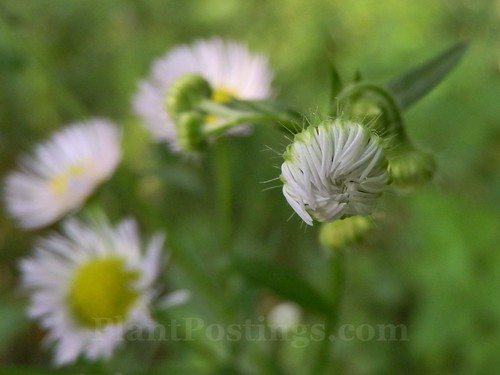
Have you noticed a recent trend toward using native biocontrols to combat non-native, invasive species?
For example, many plant experts now recommend planting prolific native plants and seeds to replace invasive, non-native plants as you remove them.
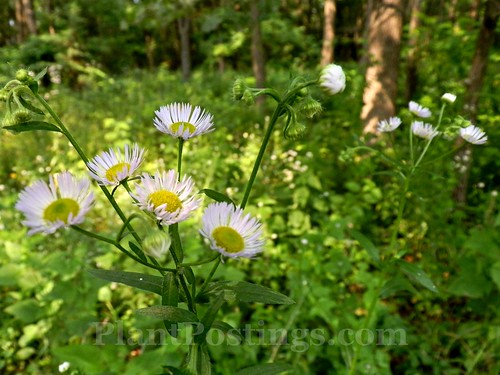
During recent state park hikes, I've noticed that Wild Columbine (Aquilegia canadensis) appears to compete effectively with non-native, invasive Garlic Mustard (Alliaria petiolata), when few other plants seem able to fight it. And in the open woods at our cottage in Central Wisconsin, Daisy Fleabane (Erigeron annuus) is another Garlic Mustard-competitor.
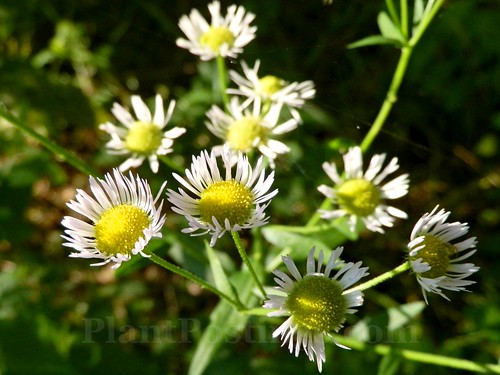
Fleabane is one of the more prominent understory plants on the property. As we pull the Garlic Mustard, the Fleabane fills in.
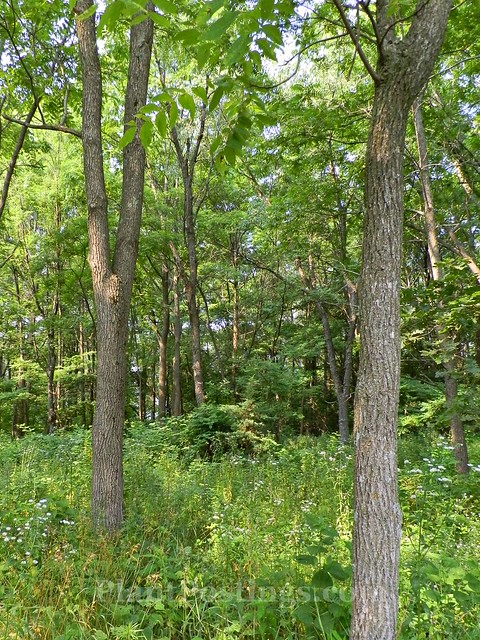
Another benefit of Daisy Fleabane is that it's juglone-tolerant, meaning it resists the toxicity of Black Walnut (Juglans nigra) trees--one of the prominent tree species at the cottage.

Daisy Fleabane also is a lovely companion to Dotted Horsemint (Monarda punctata). I don't garden much at the cottage, but I do observe what grows well in the dry, sandy soils under the Walnut trees. These two are prolific.
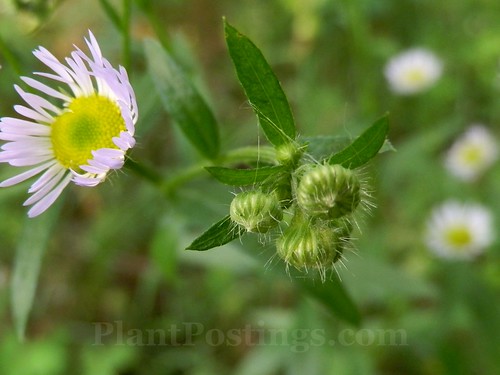
Plus, Fleabanes have cheery little flowers. They're easy to underappreciate--even though they bloom for most of the summer. A few facts about Daisy Fleabane, from Wildflowers of the United States:
Height: 2 to 3 feet
Blooms: June through September
Range: Native in all but seven states and in most Canadian provinces
There are 191 species in the Erigeron genus, with E. annuus being one of the most widespread. This one has hairy stems and a longer bloom time than some of the others. The name Fleabane, according to many sources, comes from the traditional belief (unproven) that collections of the plants placed in the home would repel fleas.
A few personal observations: Cut Daisy Fleabane has a decent vase life, lasting a few days with minimal wilting. The petals are white, with a hint of pink that becomes more evident with indirect and oblique lighting. The petals curl up as the sun fades.
If you have an area you want to naturalize while combatting invasive, non-native species, this is one option.
I like it. It's a modest, little photogenic bloomer.
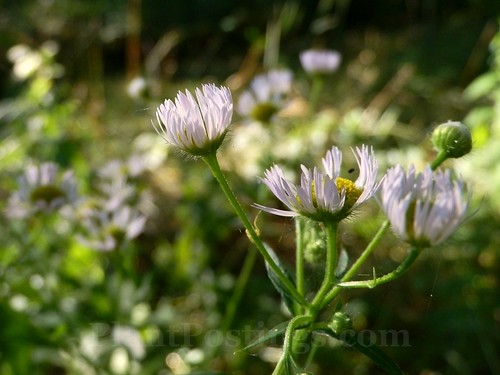
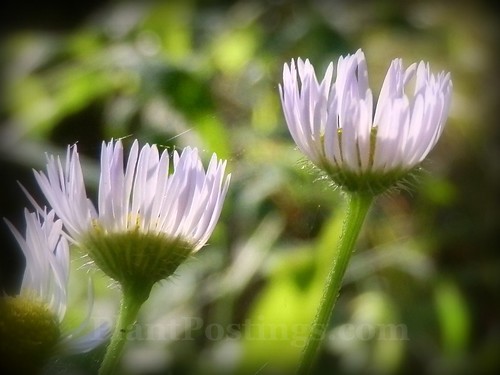
and stunning paired with the Monarda!
ReplyDeleteYes, isn't that a lovely combination? And both are drought-tolerant, grow well in sandy soils, last well in vases, and grow well under Black Walnut trees.
DeleteWhat a lovely flower, great photos..
ReplyDeleteAmanda xx
Thank you, Amanda. It grows like a weed, so I think sometimes we think of it as a "weed" in the negative sense. But it's native here and can compete with non-native invasive plants. It is very pretty, I agree.
DeleteSuch pretty little blooms! Glad to know it is tougher than garlic mustard. I've been trying to do the same thing where a patch of garlic mustard always wants to grow, but with shorter plants instead.
ReplyDeleteI need to do more of that--immediately scatter seeds and plant new, persistent native plants as I remove Garlic Mustard. Especially at home in my slightly more formal garden. ;-)
DeleteGreat plant, not one I grow, but maybe I should. Loved this post, Beth. Thanks for the good information and the gorgeous photos!
ReplyDeleteYou're welcome, and thank you! Daisy Fleabane is persistent and it does spread (self-seeds prolifically), but if you have a meadow or an area you want to naturalize with other native plants, it might be a good one to add to the mix.
DeleteWow, that's a super plant! Beats back garlic mustard and lives with black walnut! And that's good to know about wild columbine also.
ReplyDeleteYeah, I guess it has ecological restoration benefits if it can do those things. Plus, it's actually an attractive plant--kind of resembles Baby's Breath in the field and in the bouquet.
DeleteThey are very photogenic plants. It's good to know that using such native plants to combat the invasive species is working. Not only that the native insects and pollinators will benefit too. The science of it all is fascinating.
ReplyDeleteYes, I agree the science of how it all works together -- and observing that science -- is so fascinating. This plant is easy to take for granted or to dislike, if you don't like plants that spread. But in a naturalized meadow, it's a great player.
DeleteThis gives me some good ideas. I have a forested area in the back with an understory to fill, but I wonder if the fleabane would be set back by the abundance of needles that drop from the Douglas Fir trees that are in the back. We also have a lot of very tall Cherry trees and Big-Leaf Maple. All contribute to a highly acidic soil. So far I've only grown lots of fern. Do you think the pine needles would have a negative effect?
ReplyDeleteGosh, I don't know, Susie. I think Daisy Fleabane likes acid soil, but our woods is deciduous with very few conifers. There are some at the back of the lot, and I think the Fleabanes grow back there, too. Sorry, I can't help more than that, but it's worth a try! ;-)
DeleteGarlic mustard is a big problem here (not in our yard, thank goodness). Thanks for the tip. I'll pass it along.
ReplyDeleteYou are welcome! You are lucky to not have Garlic Mustard in your yard! Ours is mostly at the back of the lot in the woods, but we seem to need to pull loads of it every year. This year I scattered Wild Columbine seeds in the area where I pulled out Garlic Mustard. It will be fun to see if the Columbine fills in.
DeleteI too am pulling Garlic Mustard for the Nature Conservancy properties. Hopefully we also have the natives fill in, the plan anyway. I did not know wild columbine to be bullying out space though. Thought it more a delicate plant. Would be great if it does it here too.
ReplyDeleteI was surprised about the Wild Columbine, too, until I saw it happening at one of the state parks. So, this year, I sprinkled Columbine seeds where I took out the Garlic Mustard. I'll be curious to see if it works, next spring.
DeleteYes we have that here too....thank you for the information
ReplyDeleteYou are welcome. It seems Garlic Mustard is ubiquitous in many areas of the U.S. It does taste good, but it's such a thug ... with next to no wildlife value.
DeleteNot sure if we have garlic mustard growing here, but I will keep out a look for the daisy fleabane...with a name like that...who can't love it.
ReplyDeleteJen
Yes, it does have a fun name. I picked several stems of it recently, and it looked pretty all by itself in a mason jar. :)
DeleteI don't have garlic mustard but I do have a lot of other nasty invasives. I just started growing Fleabane so I don't know how well it will self-sow. I did grow the Monarda and it didn't come back on its own the next year. They do look pretty in your woods, though.
ReplyDeleteHi Hannah: Please keep us posted. Regarding the Monarda: Did you plant seeds or plants? I wonder if it would work better from seed?
DeleteO yes, I love those Fleabane daisies too, they are beautiful self seeders. After frostfree years the Erigeron karvinskianus is a beautiful invasive flower too.
ReplyDeleteI'll have to look that one up. Where did that one originate? Easy, pretty plants are nice to have in the garden or the wild.
DeleteDaisy fleabane is one of the wildflowers I welcome into my garden. It has never been very invasive here, just planting itself here and there, and generally I allow it to grow with minimal pulling.
ReplyDeleteBecause it's prolific, I think sometimes we think of it as a "weed." But that's a good thing when fighting non-native invasives, right?
DeleteIt is god news they can keep garlic mustard at bay.
ReplyDeleteI also have a cultivated fleabane. The bloom is just larger and pink.
I've heard about that hybrid, Alain. It sounds beautiful. We still have to pull Garlic Mustard, but the Fleabane seems to help keep it from taking over.
DeleteI don't have an issue with Garlic Mustard (thank goodness) but only yesterday was reading about it on an Ontario website on invasive species. It's wonderful that you have found an effective control using Daisy Fleabane - what a great strategy.
ReplyDeleteLucky you! Garlic Mustard seems to be more of a problem in shady gardens. Long story, but mainly I've been observing how Daisy Fleabane and Wild Columbine take over when Garlic Mustard is pulled. This past spring/early summer I did scatter some Wild Columbine seed after I pulled the Garlic Mustard. I'll be curious to see if it will emerge next spring.
DeleteI do believe that being creative by using natives will give back good results, at least in your case it looks right.
ReplyDeleteIt's worth the attempt, anyway, isn't it Lula? ;-) I find it fascinating to try different techniques in the garden.
DeleteHi,
ReplyDeleteI have always thought it pretty. :-)
Great post, thank you!
I like how you add so much information regarding the plant.
Hi Carla: You are welcome. I agree--it's a pretty, little, tough plant. And it's a good cut flower, too.
DeleteFun surprise that Fleabane is native to both our areas and it must be one of the few though we have a similar native mondarda as well. It's a great plant for late summer. I had it appear in the garden last year but not this year so I'll have to find some to continue encouraging it.
ReplyDeleteIt's always fascinating to find plants that are native and widely found in both of our regions, Shirley. This one is a tough, little beauty, and it propagates by re-seeding. So maybe that's part of the reason. I really enjoy the combination of the Monarda with the Fleabane. :)
DeleteYour pretty native plants are exotics for us here in the UK. I love the Monarda.
ReplyDeleteYes, it seems we've both shared extensively. ;-) Wouldn't it be easier if we could simply plant the plants we like with no worries about invasiveness?
DeleteLet effectively fighting invasive plants, yet it was his place, and not foreign plants. Regards.
ReplyDeleteHi Giga: Yes, many non-native plants are fine, non-invasive, and actually provide wildlife value. But when it comes to Garlic Mustard--here in my part of the world--it takes over and crowds out everything else. So, to find plants that can compete with it is wonderful.
DeleteI have come to love this plant and let it grow....I have let many of my natives grow and they now control so much of the garden I am rethinking their removal (as I am looking at a project that will never end) and move plants being smothered by them to other areas....I love that the large drifts do replace the weeds and invasives. I do a bit of control though with some plants like goldenrod and Joe Pye as I have so much....I don't consider these natives as invasive as some people do but as aggressive. And the pollinators love my natives.
ReplyDeleteYes, aggressive is a good way to put it for the native plants that tend to take over in drifts. For some of them, I wouldn't want them in a formal garden, but they have a place in meadows and wild places. :)
DeleteThey are really beautiful; their petals are so delicate and have the look of having the wind in them, and that tinge of lilac is profoundly lovely
ReplyDeleteHi Neyon: I think so, too, especially en masse or up close. The lilac tint is more apparent up close and in certain types of light.
DeleteI love that this is one of the first plants to bloom every year -- they're a pleasant sight after a long winter.
ReplyDelete